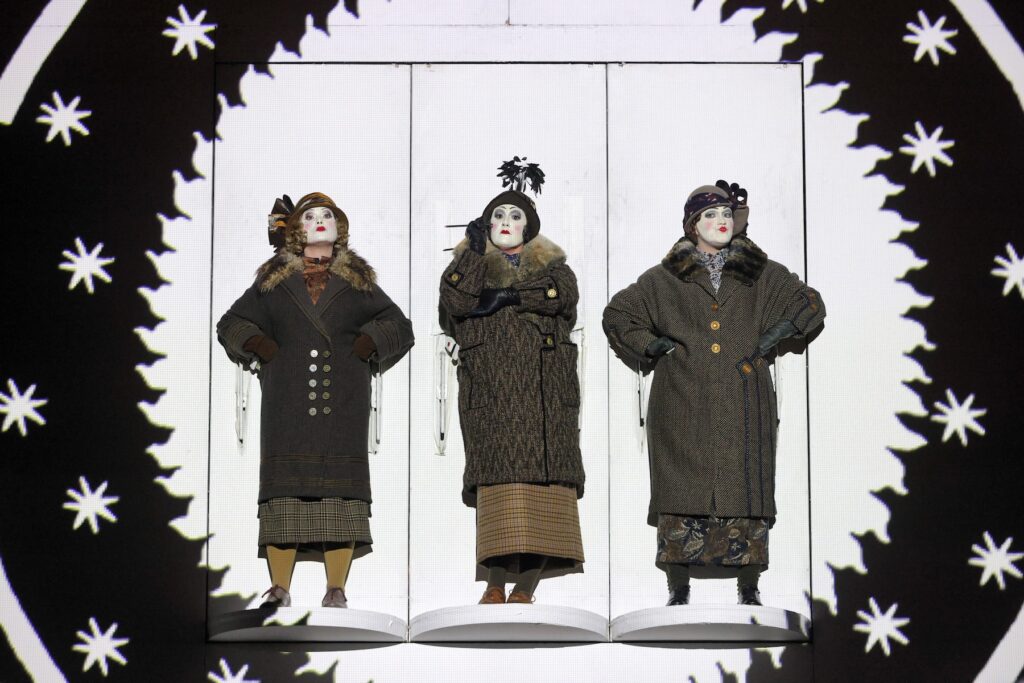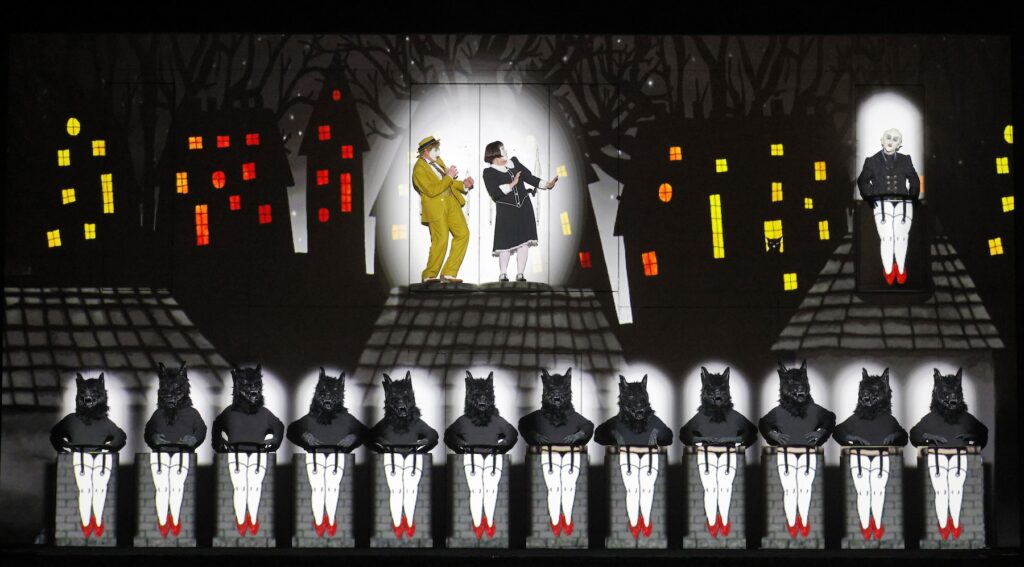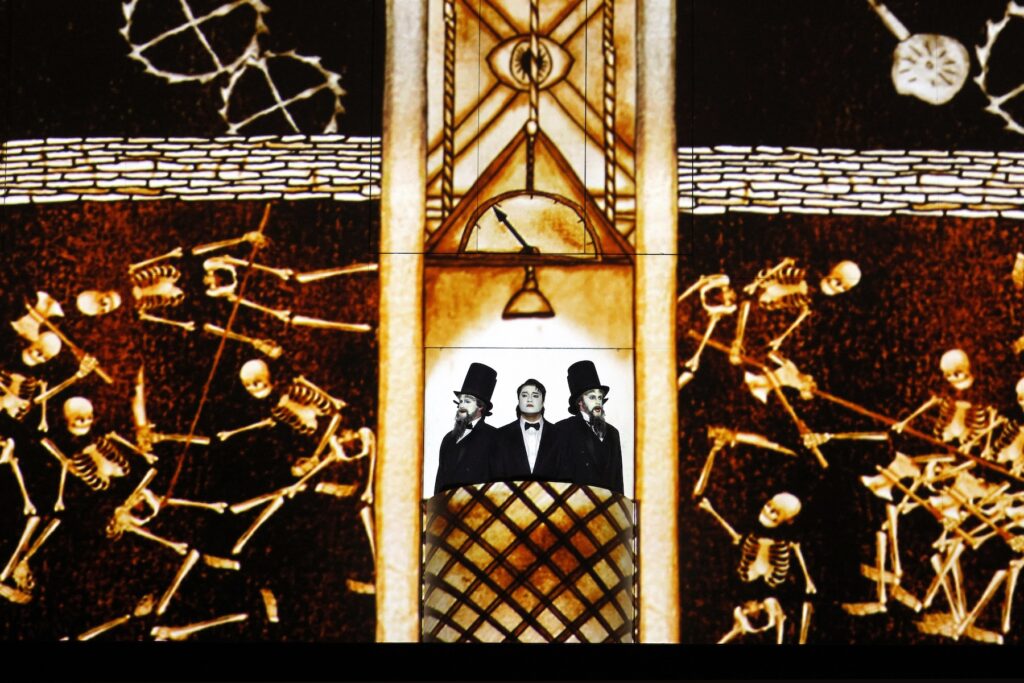It can be weird to be on the outside looking in. My very first supernumerary job with the SF Opera was for this very classic back in 2012. Amongst other things, I operated one of the three heads of a dragon. Now, I was watching from the audience for my first in-person SF Opera production since 2022 (when I switched to the safer streaming option). I also watched hoping this wouldn’t be the last show I ever saw inside the Opera House itself, as my living situation remains in jeopardy here in the Bay Area.
I’ll say this for the company’s new production of The Magic Flute (through June 30 at the War Memorial Opera House): it tries its best to take your mind off the outside world. This SF mounting of Suzanne Andrade’s 2021 Lyric Opera production throws so much at you that it can be tough to process it all, even if you understand all the references. Using modern projection tech (with animation by Paul Barritt), the show is a surreal blend of Mozart’s music, Schikaneder’s text, German Expressionist visuals, silent movie intertitles, and Georges Méliès-style interaction between film and on-stage performers.
Somehow, all of that is supposed to enhance the experience of the classic tale of lost young Tamino (New Zealand tenor Amitai Pati) who catches the attention of three supernatural ladies (Olivia Smith, Ashley Dixon, Maire Therese Carmack) who bring him before the Queen of the Night (Polish soprano Anna Simińska). The Queen has long been rival to the powerful King Sarastro (South Korean bass Kwangchul Youn) and orders Tamino to retrieve from the King her daughter, Pamina (Austrian soprano Christina Gansch). Standing in our hero’s way is the monstrous Monostatos (Chinese tenor Zhengyi Bai), but he’s aided by clumsy Papageno (German baritone Lauri Vasar) and a magical flute.

And that’s just my from-memory synopsis. I haven’t even gotten into the fact that as the Queen of the Night, Simińska never moves—she’s given the body of a giant spider via Barritt’s animation. I’d be remiss to overlook how the grotesque Monostatos (usually played in blackface as an African moor) is here made to resemble Max Schreck in F.W. Murnau’s Nosferatu. None of which gets into performers moved on-and-off through rotating wall slots, the red curtain transforming the large stage into miniature one, or the fact that the titular flute is never a flute, just an animated fairy. It’s a lot.
In fact, it’s possibly too much. With all of Barritt’s animation against the screen, the show is essentially a three-hour film with which the performers interact. This is done as far downstage as one could get, pulling off the intended two-dimensional effect, but doing so limits the performers’ movement. As mentioned, Simińska never even moves as The Queen, her arms seeming bound straight jacket-style as her animated spider body does all the work. Every performer’s job is to walk on stage, stop, and turn out towards the audience. It’s all very pretty, but the technology overtakes everything, which should never be the case in the performance-first medium of theatre.

The show tries its best to maneuver around the inherent cringe of Schikaneder’s text, but can only do so much. It tries to play the most sexist lines for winking laughs, but it’s still a story where only one woman has a name, and women are either a damsel or a villainess. The aforementioned visual change of Monostatos is better, in that it replaces the blackface with vampiric white. Still, you have a character who twice attempts sexual assault against Pamina in a story meant for kids.
The music remains lovely, with conductor Eun Sun Kim really sinking her teeth into the material. She seems to have as much fun with “Der Hölle Rache kocht in meinem Herzen” as Simińska does vocally dancing through the alternating notes. There were moments when Pati’s voice seemed to be drowned out, yet I’m not sure if that was due more to his vocals or the enthusiasm of the orchestra? Overall, the entire cast performs as best they can in a show where they’re essentially props against animated set dressing.

I went into The Magic Flute knowing that it would be the one show of the season that the company wouldn’t stream. Fortunately, regularly visiting the Opera House for the SF Ballet let me know what to expect during the still-ongoing pandemic. The Opera House HVAC system continues to impress, with my Aranet4’s CO² readings hovering around 550ppm for the entire three-hour show. That’s a relief when one of the mask straps on your MaskC KN95 unexpectedly snaps after the first act. Luckily, said strap was so tightly-looped into my rubber ear protector that the mask never loosened from my face. During intermission, I went outside and swapped the broken mask with one of the KN95s offered for free inside the press room.
Help us save local journalism!
Every tax-deductible donation helps us grow to cover the issues that mean the most to our community. Become a 48 Hills Hero and support the only daily progressive news source in the Bay Area.
The Magic Flute will always be one of those classic operas that’s a delight to hear, but a roll of the dice to see: it can be a visual delight or poorly aged horror. This particular production is so determined to load up the visual element that it seems to forget that it should be a piece of theatre first—ie. give the performers the freedom to explore the stage. It’s visually stunning and performed by great talents, but it’s a multimedia experiment above all. Since you don’t have the option to stream it, no one would fault you for wanting to witness the experiment first-hand. I certainly hope it isn’t my last.
THE MAGIC FLUTE runs through June 30 at the War Memorial Opera House, SF. Tickets and further info here.






